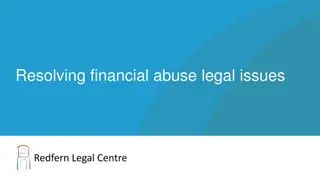Understanding Cost of Credit and Financial Statements
The cost of credit refers to the additional amount a borrower must pay, including interest and fees, while financial statements are crucial reports that present a business's financial position and performance. These statements help users make informed economic decisions by providing clear, relevant, and reliable information. The balance sheet shows the assets, liabilities, and equity of a business, reflecting its financial snapshot. Assets are categorized into current, intermediate, and long-term assets based on their value.
Download Presentation

Please find below an Image/Link to download the presentation.
The content on the website is provided AS IS for your information and personal use only. It may not be sold, licensed, or shared on other websites without obtaining consent from the author. Download presentation by click this link. If you encounter any issues during the download, it is possible that the publisher has removed the file from their server.
E N D
Presentation Transcript
cost of credit The cost of credit is the additional amount, over and above the amount borrowed, that the borrower has to pay. It includes interest, arrangement fees Some costs are mandatory, required by the lender as an integral part of the credit agreement. and any other charges.
Introduction to FSs: Financial statements are the end products of the accounting process, which reveals the financial results of the specified period and financial position as on particular date. It is the basic and formal annual report through which a business communicates financial information to its various user groups.
The objective of financial statements is to provide information about the financial position, performance and changes in financial position of an enterprise that is useful to a wide range of users in making economic decisions. Financial statements should be understandable, relevant, reliable and comparable.
BALANCE SHEET The balance sheet is a statement of financial position at a specific point in time or a financial snapshot of the business. The balance sheet reflects the result of all past transactions but not how the current financial position was obtained. The balance sheet consists of three main parts: Assets Liabilities Net worth (owner equity) Based on accounting equation Assets =Equities OrAssets =Liabilities +Capital
ASSETS Assets include anything that is owned by the entity that has monetary value. Assets has to be valued on a cost basis or on the basis of market value. Assets should be separated into three categories: current assets intermediate assets long term assets(FixedAssets and Long term investments)
CURRENTASSETS Current assets include items such as cash or assets that can and will be turned into cash within a year. Examples of current assets include: Cash in Hand and Bank Marketable securities Purchased feed, supplies, Prepaid expenses ,Growing crops INTERMEDIATEASSETS These assets can not be converted or sold for cash in short period of time Ex: milch and draught animals, small equipments, etc. These assets are not consumed within the year and continue to give returns beyond one year.
LONG TERM ASSETS These assets support production activities and are considered to have a life greater than one year. They are of permanent nature. In agriculture, common long term assets include Buildings Land Shares in other entities
LIABILITIES Liabilities are financial obligations of the business, such as money owed to lenders, suppliers, employees, etc. Any type of borrowing from persons or banks for improving a business or personal income that is payable during short or long time Liabilities should be separated into three categories: i) current liabilities ii) intermediate liabilities iii) long term liabilities
CURRENT LIABILITIES Current liabilities include all debts and obligations that are due within the next 12 months. current liabilities are: Accounts payable (bills, taxes, etc.) Operating loan balances Principal portion of term loans due within the next year ,Accrued interest on all loans INTERMEDIATE LIABILITIES These are also called as medium-term liabilities , Medium term loans/liability are those whose maturity is between 1 and 7 years , Ex: cattle loan, sheep loan Long term liabilities ,Long term loans/liability are those whose maturity period is more than 7 years. , Ex: land mortgage Examples of some common
OWNER EQUITY Owner equity, or net worth, is the difference between total assets and total liabilities. It reflects the owner s stake in the business and includes investment capital and retained profits. Total assets Total liabilities = Equity have owe what you are worth
INCOME STATEMENT It is a measure of revenue and expenses during a specified accounting period (usually a year). It provides a fairly good picture of income earning and managerial ability of the farmer, in case drawn over a number of years. Moreover, an income-statement can be constructed either for a farm business or of a farm operator. Once prepared for a farm business, it reveals the success or failure story over time together with the costs and returns associated in the use of capital or credit STATEMENT (OR) PROFIT AND LOSS
Usually, the income statement considers the various types of income such as (a) cash revenue from sale of crops, livestock and its products, earnings from custom hiring and cash receivables, (b) kind income such as, value of farm produce consumed by the family, the rental value of farm dwellings, (c) unrealized income such as inventory changes, (d) miscellaneous sources,
CASH FLOW STATEMENT It is also called as the sources and uses of funds or flow of funds statement. It is prepared either for a farm business or to a farm operator s family. In Cash flow statement both the cash in flows and out- flows are summarized over a given period of time. In a cash flow statement the total cash inflows must equal to the total cash out flows.
























